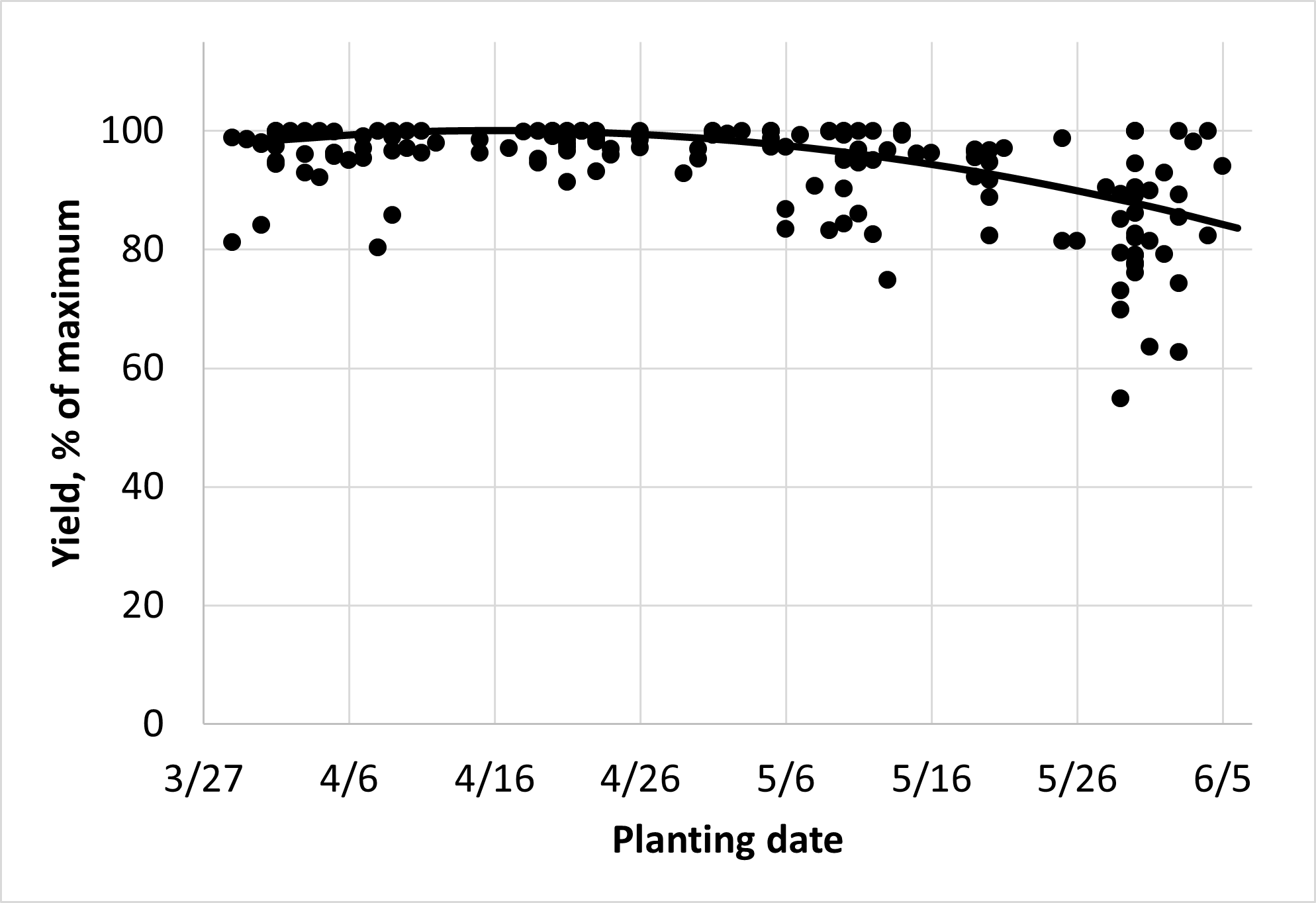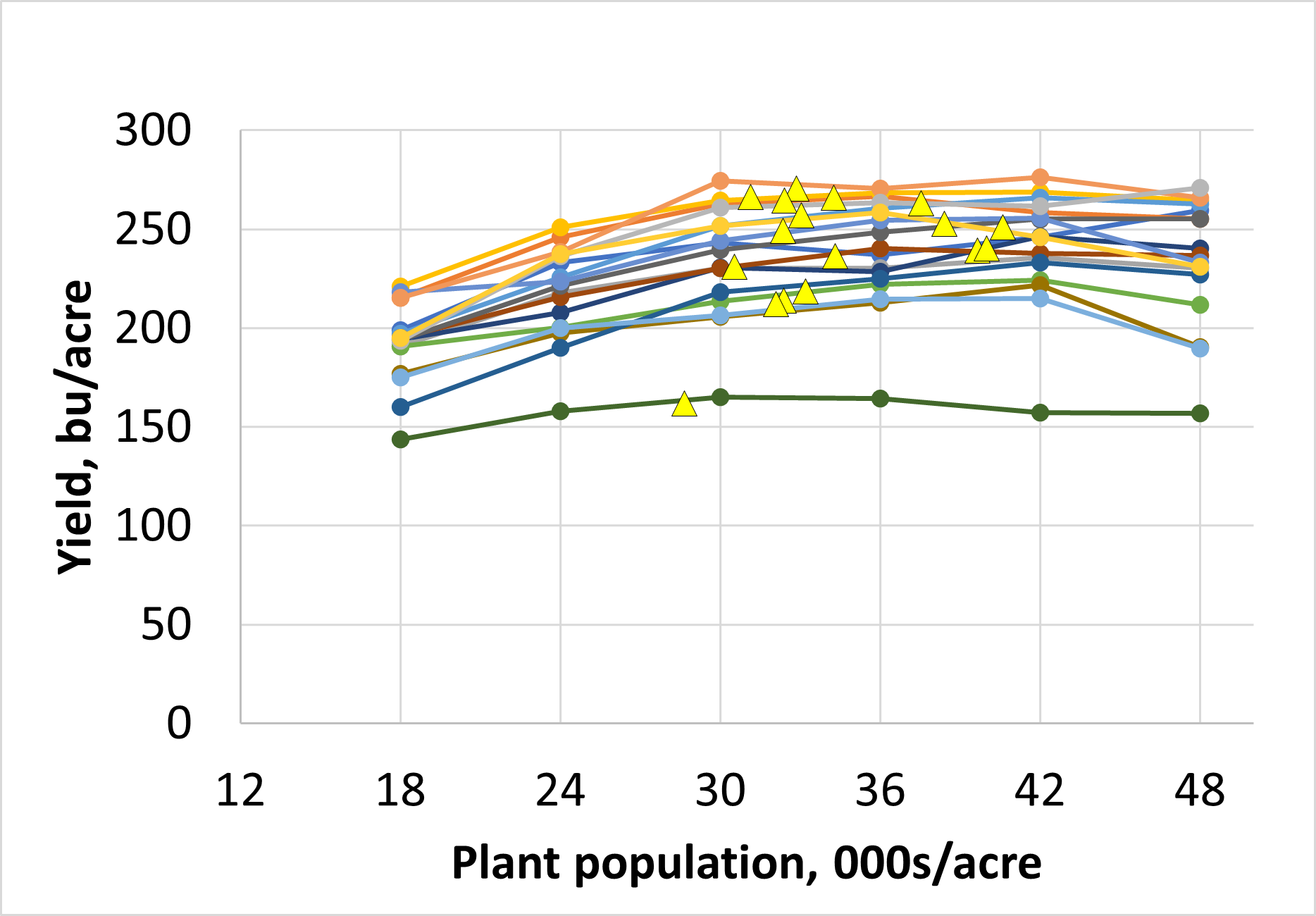Planting corn in 2023
March rainfall ranged from about normal to an inch above normal in the northern half of Illinois to twice normal in the southern end of the state. NASS reported 1.7 days suitable for fieldwork for the week ending on April 2, and soil moisture is rated as adequate or surplus in more than 95% of the state. Up to an inch of rain fell in the first week of April, but dry weather is in the forecast, so planting in some areas may not be far away. Those producers who wait to plant, or to think about planting, until after Easter (April 9 this year) do not have long to wait.
Temperatures have averaged a degree or two below normal over the past 30 days, but with wild swings—in Champaign, the low/high temperatures on March 19 were 14/19 degrees, and on April 5 were 58/82 degrees. The forecast is for near-normal to above-normal temperatures in the coming weeks. Bare-soil temperatures at the 4-inch depth have been reaching daily highs in the 50s and 60s over the past week, and should continue to rise slowly, helping soils to dry out in the coming weeks. So we can be somewhat optimistic that planting may get underway before too long, and that conditions for planting might be favorable.
Planting date
Although we place a great deal of emphasis on the need to plant early, and spend a lot for equipment to allow us to do that, statewide planting progress and yields are not as tightly linked as many people believe they are. Figure 1 shows the 50%-planted date and deviation from trendline corn yield for Illinois over the past 33 years. The trendline yield increased by 78 bushels—from 122 to 200—over that period, and “detrending” the planting date response helps us to see it more clearly. The point in the lower left is from the drought year of 2012, when planting was the earliest on record, but the dry weather that allowed such early planting persisted into mid-summer, dropping the yield to 70 bushels below trendline.

Without 2012, yields ranged from 24 bushels above to 21 bushels below trendline yield, without a strong relationship between planting date and yield. The largest deviations (more than 18 bushels) above trendline, however, came in years when half the crop was planted by May 5; in only two years with later planting did yield exceed trendline by more than 6 bushels. Yields more than 10 bushels below trendline were distributed from some of the earliest to the latest planting dates; nearly all of these were in years when July rainfall was below normal; in only one year (1994) was July rainfall more than an inch below normal, but yield was well above normal. When the crop gets planted in less important than the amount of mid-summer rain, but the best use of summer sunlight still tends to come when planting is relatively early.
Figure 2 summarizes the results of 42 planting date trials in central and northern Illinois. While the best yields across trial came from planting by the end of the first week of May, there were a few trials—all with relatively low yields—where planting before April 10 lowered yield, and a few trials where planting in late May or early June produced the same yield as planting in mid- to late April.

Should we ever choose to delay planting?
Seeds have three basic requirements to germinate: water, warmth, and oxygen. While we no longer pay a lot of attention to soil temperature as the “go” signal for planting, soils that are relatively warm at planting and then stay warm after planting can provide an ideal start for the corn crop, including, in some cases, higher yield potential. Having soils stay dry after early planting (into cool soils) is better than having them turn wet: the germination process is very slow at low temperatures, so seeds will bide their time until soils warm up, and dry soils are a safer place to do that.
If it does turn wet after planting, seeds will last longer in cool soils than in warm ones, both because low temperatures delay the germination process (and the demand for oxygen), and because colder water contains more oxygen than warmer water. Still, seeds that spend a week or more in wet soils at temperatures in the low 40s are subject to “imbibitional chilling injury” that can mean abnormal growth and poor emergence even if seeds survive. We also believe, based on observations, that temperatures in the upper 30s to low 40s after the crop emerges might also have a physiological effect that lowers yield potential, although we don’t know what that effect might be.
Without the ability to know what the weather after planting will bring, we don’t have a great basis on which to decide whether to delay planting on purpose. In many, but not all, years, there ends up being a planting window sometime in late April or early May that brings lower yield for corn planted then. This window is often identified, after the fact, as opening with a heavy rainfall event that affects corn planted right before it. That may simply be a case of lower stands from crusting or standing water. But when such heavy rain is brought by a cold front moving through, low temperatures typically add to the damage, even if plants manage to emerge. We have some evidence that the yield loss with delayed planting shown in Figure 2 is considerably less than it was with older hybrids, especially on a percentage basis. So it may make sense to some to delay planting, especially if it’s still April, and the forecast is for a cold front to drop 2 or more inches of rain, then warm, dry weather to follow that.
Planting depth and placement
Most planting depth studies include planting both too shallow and too deep, with a few depths in the middle, and results typically show, to no one’s surprise, that it is better to avoid planting too shallow or too deep. Planting too shallow can expose the seeds to drying conditions before germination begins, and can limit the uniform uptake of water by all of the seeds. It can also, especially if rainfall washes some soil away from the row, result in shallow placement of the crown, making it more difficult to form an effective nodal root system. On the other hand, deeper planting delays emergence, especially in heavy soils that tend to crust. The depth range that makes sense for planting into silt loam or heavier soils is 1.5 to 2 inches deep. Most corn seed has the ability to emerge from 3 inches deep if soil conditions are good, but when soil conditions deteriorate after planting, seeds that are that deep may struggle to emerge. There is no known advantage to having seed that deep; the risk is nearly all on the downside.
Most new planters are very good at spacing seeds uniformly down the row. While there is little evidence that corn dropped with a CV (coefficient of variation) of 1% yields more than the same population with a CV of 5% (that is, with more plant-to-plant variability.) Many planter monitors now give a CV reading by sensing seed drop during planting, and planters with high delivery accuracy (seed mechanically moved from the meter to the seed furrow rather than being dropped down the seed tube) do an excellent job of spacing seed uniformly, even at high planter speeds. Uniformity of depth placement and of soil-to-seed contact produced by the firming mechanism are much more difficult to accomplish and to measure, but most stands in Illinois corn fields are very good to outstanding, regardless of the age of the planter.
Seeding rate
Figure 3 below shows the response to corn plant population in 17 sites in Illinois between 2016 and 2018. Each trial included four to six hybrids, with planted populations (and stands, which were nearly identical) ranging from 18,000 to 48,000 per acre. Yields at 48,000 plants were lower than those at 36,000 plants per acre. The curve fitted to the data for each trial showed that the optimum population—where the last seeds added increased yield just enough to pay for that seed—ranged from less than 30,000 (in a dry location) to just over 40,000. The maximum yield required populations 2,000 to 6,000 higher than the optimum, but the yield added was not enough to pay for the extra seed. Optimum population was unrelated to yield level—the highest-yielding sites did not require the highest populations.

Overall, planting 36,000 across all of these trials would have optimized seeding rate, with a little income lost from lower yield where optimum rates were higher than 36,000, and income lost to higher seed costs where optimum rates were lower than 36,000. If we had a basis for varying seeding rate from field to field, that could have boosted profits some. These trials were on similar soils at four or five sites over the three years of the study, and yield and population responses differed more by year than by location (soil productivity). This illustrates the difficulty in finding a basis on which to vary seeding rates, at least within and among fields with good uniformity of soil type and productivity. That doesn’t mean we shouldn’t vary populations, but we should not vary them over a very wide range in relatively uniform fields, and we even the lowest population in a field should be high enough to enable high yields when the season is favorable.





